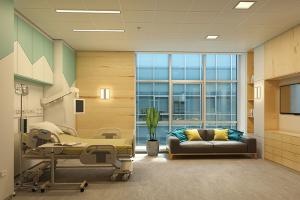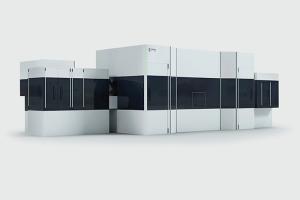CMMS features improve health facility operations

Mobility, connectivity and data visualization are key features of the newest computerized maintenance management systems (CMMSs) for hospitals and other health care facilities.
Smart use of data is also crucial. The most effective CMMS can be set up to analyze equipment condition and needs, manage contractors, analyze workflow efficiency and customer satisfaction, and accurately track labor and material costs with little technician effort. This allows maintenance professionals to focus on performance improvement.
Timeliness and attention to detail also are critical to improving the patient care environment, but they are the biggest challenges that CMMS providers face, says George Mills, director of health care technical operations at JLL Inc., Chicago. “The staffing and time required to take advantage of full CMMS capabilities can be difficult to allocate into budgets,” he says. “Underutilizing a CMMS can be a major source of missed opportunities to drive workflow efficiency and cost savings.”
Medical equipment, facilities and personnel vary greatly. “The key to a good CMMS is flexibility and the ability to meet multiple standards, especially around confidential data, audits and e-signatures,” says Greg Dierickse, product marketing director at Fiix, Toronto.
Software integration is an additional challenge. Hospitals run several applications and services that vary between departments and require seamless integration for proper functionality.
Cybersecurity is important as well. More equipment connected to the hospital network has increased the risk of a breach that can affect both patients and equipment, says Ben Mannisto, president and CEO of Phoenix Data Systems Inc., Southfield, Mich. “This makes it imperative that CMMSs not only record all relevant integration information, but also provide immediate customer notification to mitigate any found issues.”
Going mobile
Mobility is a key feature of the CMMS available from Smart Facility Software, Nashville, Tenn. “We see smartphones and tablets becoming ‘a must’ as time marches on. Given a workforce spread over large facilities and campuses, smartphones and tablets with the right apps solve many communication issues,” says Mark Clabaugh, chief technology officer.
Both technician mobility and effectiveness are improved with smartphone capabilities, according to Michael A. Watson, product application specialist at Fluke Reliability, Everett, Wash. “Mean time to repair can be improved 90% by having data available at the point of repair instead of accessing multiple systems from kiosks or terminals,” he says. “There is a trade-off between ease-of-use in a smaller smartphone device versus larger display screens for visualization of drawings, systems or multidimensional data via tablets.”
The use of tablets versus smartphones depends on the need. Departments such as health technology management require more access to equipment history and ancillary test equipment, so tablets and laptops may be more suitable to these operations. For hospital facility management, smartphones are a good solution that allows work to be quickly and efficiently assigned and completed.
“Our Connectiv platform can readily accommodate any portable device,” says Rick Joslin Sr., senior adviser of health care strategy, Accruent, Austin, Texas. “Remote temperature and humidity monitoring and other sensor-driven capabilities, which move things into a more predictive realm, are becoming more prevalent. Our CMMS can support integration and automated notification from these devices.”
Fiix offers a SaaS-based CMMS that features a new mobile app for both Apple and Android. It helps facilities managers schedule tasks, keep track of past work, and improve communications between the maintenance team and other departments.
Data analysis
Deep data analysis is another key feature. For example, Phoenix Data Systems Inc. has developed a fifth generation CMMS, called AIMS 3. With built-in metrics and machine-learning algorithms, it instantly alerts users when they are drifting away from acceptable performance levels, costs, task results, compliance and other traceable metrics. “AIMS 3 offers improved workflows and more information at one’s fingertips, so technicians spend less time manipulating the software and more time out on the floor taking care of medical equipment and maintaining facilities,” Mannisto says.
The biomedical and facilities CMMS available from MediMizer Software, Encinitas, Calif., features preventive maintenance scheduling, work order processing, built-in reporting and parts inventory tracking. “After 35 years, MediMizer is now completely mobile,” says Mark Woodruff, chief technology officer. “New customers no longer require client installation, which reduces the cost of operation.”
SMGlobal Inc., Apex, N.C., recently released FastMaint CMMS v.11. New features include a web application programming interface to retrieve and update information via third-party apps, more work order scheduling options, and user interface improvements. “Since many organizations are struggling during the current pandemic, the previously retired basic edition has been revived. This lower-priced edition is designed for sites with fewer assets to manage,” says Sanjay Murthi, manager.
Dude Solutions Inc., Cary, N.C., recently released BioMed for TheWorxHub, an asset-based workflow management tool that helps track the work of clinical engineers and technicians to drive productivity and ensure compliance. Designed to empower biomedical teams to transform the demands around managing medical equipment into a streamlined workflow, BioMed is an intuitive system designed to help hospitals improve patient care and staff safety.
“Built-in tools such as speech-to-text and timers improve transparency and accuracy, while providing the ability to add photos and signatures to work orders,” says Braden Witt, health care product manager at Dude Solutions. “Also, the system offers detailed inventory and documentation on each asset as well as integrated bar coding to update information with the push of a button.”
EQ2 LLC, Charlotte, N.C., has released Version 8 of its HEMS CMMS software. HEMS helps hospitals stay in compliance through tracking and reporting features that address the environment of care, fire protection, and critical utilities and their respective elements of performance.
The latest EQ2 upgrade includes a HEMS remote mobile app, which works on Windows, Android or Apple (iOS) platforms, and can be downloaded from Play Store, iTunes or Windows Store. With this feature, the user need not be connected to the hospital network to locate and complete work orders. “The technician or mechanic has total access to scheduled or unscheduled work orders, which can be updated from remote locations,” says Rich Sable, product manager.
zLink Inc., Maynard, Mass., offers a maintenance management platform comprised of 25 software components that are integrated to meet a broad set of hospital requirements. “This provides an environment for optimizing space utilization, maintenance, and management of mobile and fixed assets, and facility condition assessment for detailing deficiencies and remediation costs,” says Anupam Sachdev, CEO. “This data can be aggregated to provide decision alternatives for maintenance and capital planning budgets.”
The environmental services-based Smart Facility Software recently introduced the task dispatch decision engine and HL-7 interface. The task dispatch decision engine gives software users the ability to automate who gets which task when a request comes into the system. For example, when a discharge or transfer comes through, the software looks through the decision engine to find the appropriate employee to clean that room.
As patients are discharged or transferred in a facility’s admission, discharge and transfer (ADT) system, HL-7 messages are sent to an interface engine, and tasks are triggered in the service optimizer software to clean patient rooms. The decision engine distributes these tasks throughout the workforce. When team members mark a room “clean” on their mobile devices, it triggers an HL-7 message to let ADT know the room is clean.
“We are interfacing our software with the hospital’s HL-7 interfaces. This means we can exchange information with ADT systems to trigger cleaning tasks, as well as update bed status. Our software does not hold any HIPAA information. So any patient information gets stripped at the interface engine level, which is HIPAA-compliant,” Clabaugh says.
Artificial intelligence
Sachdev of zLink says artificial intelligence (AI) software can provide major operating efficiencies in asset utilization. Examples include preemptive maintenance alarms based on use that reduce the downtime of major care assets such as radiation therapy and magnetic-resonance imaging machines.
Eagle Technology Inc., Mequon, Wis., has introduced mobile, bar code and quick response codes to scan and access machine and building data. The mobile application makes it easy to send, access and create work orders and to record information using a camera via smartphone or tablet. “Ask Steve,” an AI chatbot, allows users to converse with their database in order to extract work history in the form of charts and graphs. “These features help hospitals track and gather data and gain insight into their historical data,” says Harshad Shah, president and CEO.
In 2019, Fiix acquired an AI company, Alchemy IoT, and has since been embedding the technology into its core CMMS, looking into how to analyze equipment level data, work orders, and parts and supplies consumption. “The AI will help predict and provide greater insights into proactively managing maintenance and helping ensure that equipment is running at optimal efficiency,” Dierickse says.
However, AI can’t quite replace the skilled labor required in hospitals — roles such as biomedical and HVAC technicians who have mastered their craft over the years, according to Witt of Dude Solutions.
“We’re seeing AI becoming important on the clinical side, but it’s not going to be the key to how boilers are cleaned in the future,” Witt says. “But machine learning combined with a well-tested and deployed ‘internet of things’ may help ensure that often overlooked, yet critical, aspects in hospitals are cared for, such as the placement of wheelchairs.”
Mills of JLL can envision a time when equipment becomes self-diagnostic. However, this cannot happen without complete CMMS data to analyze. “With a properly implemented CMMS, hospitals will eventually be able to proactively manage equipment service activities and scheduling, anticipate capital needs, predict staffing shortages and more accurately forecast budgets,” he says.
Advances ahead
Many vendors predict that more connections to smart devices will provide insight into the need for periodic maintenance and building system faults. Others predict an integrated environment that includes maintenance requesters, providers and supply logistics.
Sable of EQ2 sees more built-in intelligence and back-end automated processes evolving to assist facility professionals, thereby making their jobs easier and more productive.
“Essentially, a CMMS will become the network hub for all associated internet of things and AI applications,” Sable says. “It will provide a comprehensive view of all the systems that both create and distribute tasks to the appropriate work unit or shop.”
Neal Lorenzi is a freelance writer and regular contributor based in Mundelein, Ill.

CRITICAL COMMUNICATIONS
“Ask Steve” allows users to converse with their database in order to extract work history in the form of charts and graphs.
Eagle Technology Inc.
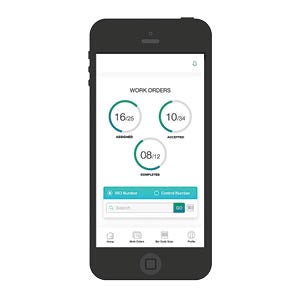
SOFTWARE FLEXIBILITY
The HEMS remote mobile app works on Windows, Android or Apple (iOS) platforms. EQ2 LLC

HIGH-TECH EVS
A technician sees this screen when a discharge clean task arrives at their mobile device after information is sent via the HL-7 interface and is distributed via the decision engine. Smart Facility Software
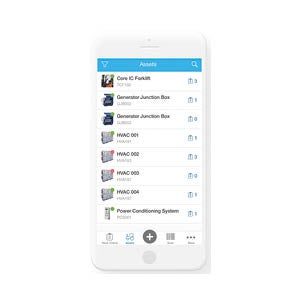
ALWAYS ON
The Fiix mobile CMMS app asset listing works online and offline, providing access to asset information. Fiix
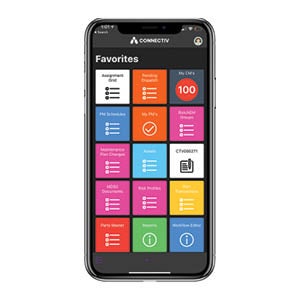
FIELD READY
he Connectiv mobile platform empowers technicians to enter and update preventive and corrective maintenance work orders as the work is being performed in the field. Accruent
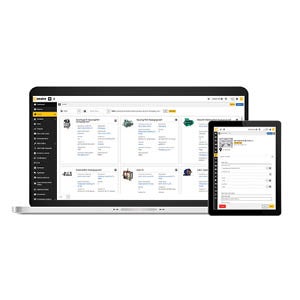
ALL IN
Emaint allows users to monitor asset data across all plants and facilities via PC or smart device. Fluke Reliability
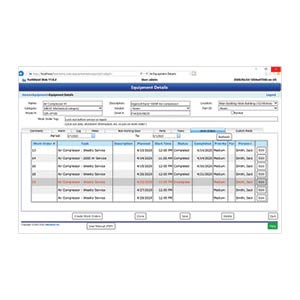
APP READY
FastMaint CMMS v.11 features a web application programming interface that retrieves and updates information via third-party apps. SMGlobal Inc.

SMART SEARCH
This utilities module allows users to locate smart energy meters using 3D drawings. zLink Inc.

RELEVANT AND RETRIEVABLE
Customizable dashboards allow Corrigo users to quickly access the data most relevant to their role and manage by exception. JLL Inc.
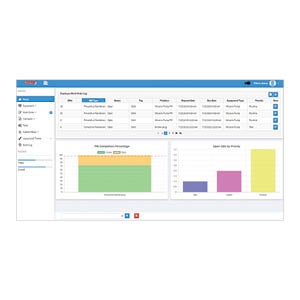
INFORMATION RICH
A user-specific home screen features workloads and a preventive maintenance completion percentage chart among other optional charts to put all relevant information at the user’s fingertips. Phoenix Data Systems Inc.
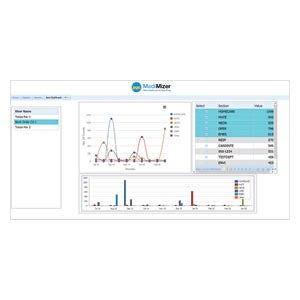
MAJOR MOBILITY
With the iRequestManager, users can quickly generate work requests from anywhere in a hospital that can be sent to devices, email or printers. MediMizer Software

ASSET EXPANDABILITY
BioMed for TheWorxHub provides a simple way to track and manage equipment with asset standardization and an evaluation process for adding approval rules to new equipment models. Dude Solutions Inc.


